The Motorola Moto G4 and G4 Plus Review
by Brandon Chester on August 15, 2016 8:00 AM EST- Posted in
- Smartphones
- Lenovo
- Motorola
- Moto G
- Moto G4
Battery Life
Regardless of how good a phone's hardware is, if it can't last through the day then it's never going to provide a good user experience. We use a few different tests to analyze the battery performance of a mobile device under different workloads that put a heavy stress on a certain part of the system. In our web test, the workload is display-bound, although there is a significant amount of CPU processing done which will impact results. In GFXBench the test is GPU-bound, and in PCMark the test tries to simulate typical interactions that will make use of all the hardware. For these benchmarks I've opted to just test the Moto G4 Plus, as both the G4 and G4 Plus share the same SoC, display, and battery capacity, so there should be no difference between the two as far as battery life is concerned. As always, I'll start with our own WiFi web benchmark before moving to the battery tests that exist as part of the performance benchmarks that we use.
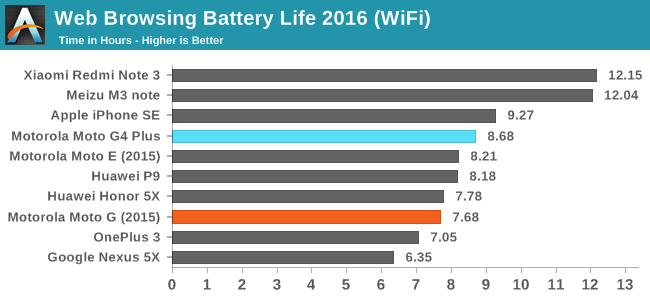
In our internal WiFi web browsing test the Moto G4 Plus lasts exactly one hour longer than the 2015 Moto G. This isn't surprising given the significant increase in the battery capacity with the move to a larger form factor, but it does put to rest any concerns about the Moto G4's higher resolution display leading to worse battery life in display-bound workloads than its predecessors.
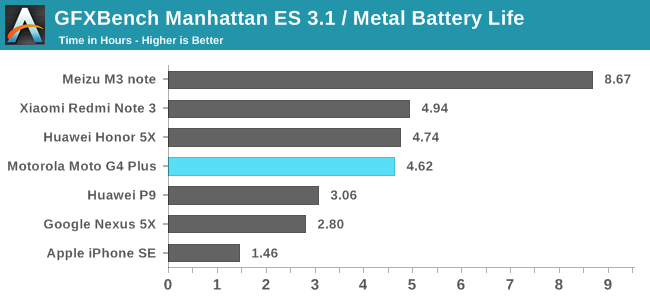
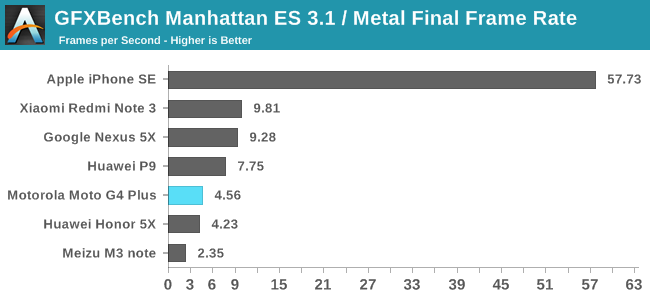
The Moto G4 performs as expected in the GFXBench Manhattan ES 3.1 battery test. Both the runtime and performance are in line with the Huawei Honor 5X, which has essentially the same specifications. Obviously a frame rate of 4.5fps isn't going to be playable, but in a graphical workload more reasonable for the Moto G4's hardware you should be able to play for a good period of time before your battery dies.
Normally I would run PCMark's battery benchmark, which is my favorite battery test because it performs tasks that users do on a daily basis. In my view it provides the best idea of whether or not a phone will last through the day. Unfortunately, I couldn't get the Moto G4 or the G4 Plus to complete the test. Early on in the benchmark it would simply freeze, and the phone would sit there in that state until it drained and died. I attempted the test three times, at which point I gave up on my attempts. The only other device this has happened to is the Google Pixel C, and we all know how that turned out. Suffice to say, this kind of issue is a hint that there are probably other software problems and stability issues in the phone's firmware, and it's not a good sign.
Charge Time
Something that I found to be quite ridiculous about previous versions of the Moto E and Moto G was the charger included in the box. This was market dependent to a degree, but in North America the first problem with the charger was that it had a low power output of roughly 2.5W. This meant that the phones charged incredibly slowly, which was a big problem when paired with the relatively large batteries in the 2015 Moto E and Moto G. On top of that, the charger was a single unit where the block and cord were connected together, rather than being a separate block and cord. This meant that by default, the Moto E and Moto G could not be connected to a computer to transfer media.
While the old charger could be somewhat excused as a cost saving measure, Motorola has clearly recognized the ridiculous nature of it. With the Moto G4 and G4 Plus they now ship a separate cord and charger. Something that confuses me is the fact that Motorola's website explicitly advertises that the G4 Plus ships with their 15W TurboPower charger. While this is the case, the normal Moto G4 unit I received also has it so it's not really a selling point for paying the extra $50 from what I can see. I'm not sure if this differs by market, so it's probably best to check the box when buying to see what charger you get inside.
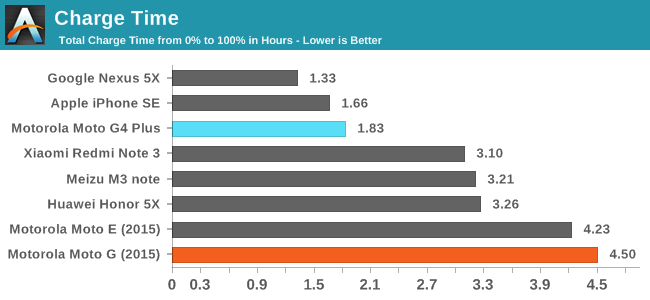
By including a reasonable charger in the box, Motorola has cut down charge time significantly. The 2015 Moto G had the longest charge time on record for a smartphone, while the Moto G4 Plus is in line with what is expected of modern smartphones. Fast charging has more than halved the time it takes to charge the battery fully, despite the fact that the battery has increased in size from 2470mAh to 3000mAh. My only complaint is that Motorola's TurboPower charger makes a whining noise when the phone reaches a full charge and is left connected. I noted this around the time of the Nexus 6 review as it uses the same charger, and I was told by many users that they don't experience this. However, I now have three of these 15W TurboPower blocks and they all do it, so I think it actually comes down to whether or not you can hear the frequency emitted. If you want to look on the bright side, it lets you know when your phone is done charging, but I think I'd rather have an LED indicator instead.


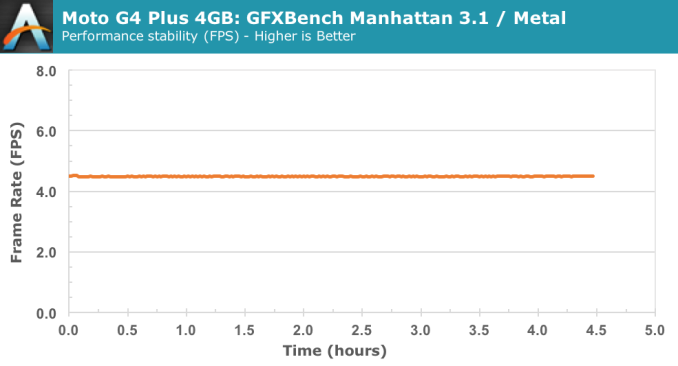
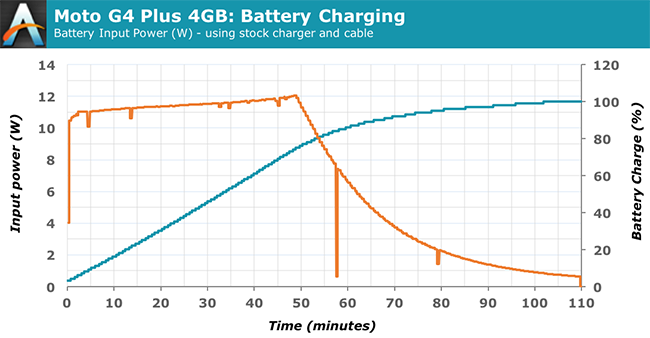








94 Comments
View All Comments
Cod3rror - Monday, August 15, 2016 - link
It does have a gyroscope, but this time it does not have a magnetometer (G3 has magnetometer but no gyroscope), so you're not going to be able to use compass applications.Rrskda - Monday, August 15, 2016 - link
How important is the magnetometer? From what Google tells me, it's the least useful of the three (including accelerometer, gyroscope).Cod3rror - Monday, August 15, 2016 - link
How important is it for you for the map to rotate smoothly when you turn your phone?Meteor2 - Sunday, September 11, 2016 - link
Maps should always have north at the top.raju516 - Monday, August 15, 2016 - link
The poor performance is due to the 617 chip not firmware as i see no phone with 615,617 that performs well atleast day to day tasks. Many reviewers while revieiwnfg phones with 615, 617 attribute the poor perfromance, stuttering to firmware which is not the case. The 615,617 overheats easily and are worst processors till date.cbm80 - Monday, August 15, 2016 - link
They embiggened it and made it cromulent, but they failed to make it performant!Atakelane - Monday, August 15, 2016 - link
"Choosing an eight core Cortex A53 SoC to appeal to the Chinese market instead of a six core Snapdragon 650 was not a good decision for the user experience.". What an irony. The Chinese Xiaomi uses the SD650. I, think Moto got their strategy all wrong for the Chinese as well as global market.Coming to the overheating issues, Moto seems to have hit a bump with the SD6XX series cpu's. Even the Moto G3 Turbo, with SD615 has terrible heat issues. The normal G3 on the other hand extracted the best possible performance from the SD410.
So, why does a cpu that performs well in phones like Asus Zenfone Selfie and LG G4s, fare poorly in all Moto phones (G4, G3 Turbo, Moto X Play) ? Weird. Where is it, that Moto going wrong? Has Lenovo something to do with it, as all the problematic phones were launched after Lenovo acquired Moto?
vLsL2VnDmWjoTByaVLxb - Monday, August 15, 2016 - link
Typo, Page 6:want to look *onn* the bright side, it lets you know when your phone is done charging,
Brandon Chester - Monday, August 15, 2016 - link
Good catch. Thanks.junky77 - Monday, August 15, 2016 - link
There is another factor that should be considered - previous generation 'premium' smartphones are now selling for $230-$250 (Nexus 5X) and are probably better than these by a lot, overall. So, why get the Moto G Plus instead of the 5X?